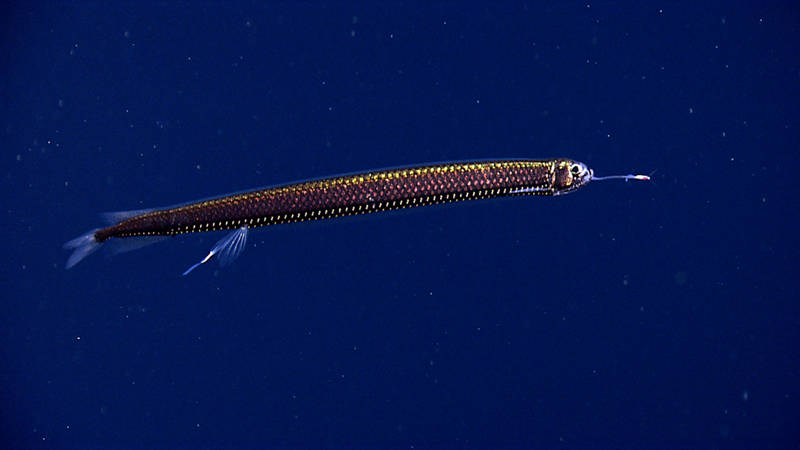
During our mid-water transects, ROV Deep Discoverer imaged a dragonfish. Image courtesy of NOAA Okeanos Explorer Program, Our Deepwater Backyard: Exploring Atlantic Canyons and Seamounts 2014. Download larger version (jpg, 1.4 MB).

During our mid-water transects, ROV Deep Discoverer imaged a dragonfish. Image courtesy of NOAA Okeanos Explorer Program, Our Deepwater Backyard: Exploring Atlantic Canyons and Seamounts 2014. Download larger version (jpg, 1.4 MB).
During the final dive of Leg 3, we conducted the first-ever exploration of Nantucket Canyon. Remotely operated vehicle Deep Discoverer (D2) landed on a sedimented seafloor with several eels, urchins, and brittle stars at a depth of 1,872 meters. In the area surveyed, sea pens were the most diverse faunal group; brittle stars and sea stars were the most abundant. D2 transited up a soft sediment slope with a few outcrops of hard rock and we encountered octocorals, stalked crinoids, several different species of sea pens, sponges, anemones, brittle stars, a couple different species of fish, sea spiders, and zooanthids. Cup corals, black corals, bamboo corals, paramuricea corals, chrysogorgia, and several colonies of Anthomastus were all documented during the dive. The dive concluded with several mid-water transects where D2 imaged larvaceans, ctenophores, jellyfish, a squid, mid-water fish (including a dragonfish), shrimp, salps, siphonophores, and a couple of organisms our experts couldn’t identify. Today’s highlights included the diversity of sea pens and abundance of brisingid sea stars, a particularly large caprellid amphipod, and a number of small corals that indicated active recruitment.